  |
The History of the Edison Cylinder Phonograph
Timeline of Edison's life
click here
The phonograph was developed as a result of Thomas Edison's work on two
other inventions, the telegraph and the telephone. In 1877, Edison was
working on a machine that would transcribe telegraphic messages through
indentations on paper tape, which could later be sent over the telegraph
repeatedly. This development led Edison to speculate that a telephone
message could also be recorded in a similar fashion. He experimented with
a diaphragm which had an embossing point and was held against
rapidly-moving paraffin paper. The speaking vibrations made indentations
in the paper. Edison later changed the paper to a metal cylinder with tin
foil wrapped around it. The machine had two diaphragm-and-needle units,
one for recording, and one for playback. When one would speak into a
mouthpiece, the sound vibrations would be indented onto the cylinder by
the recording needle in a vertical (or hill and dale) groove pattern.
Edison gave a sketch of the machine to his mechanic, John Kreusi, to
build, which Kreusi supposedly did within 30 hours. Edison immediately
tested the machine by speaking the nursery rhyme into the mouthpiece,
"Mary had a little lamb." To his amazement, the machine played his words
back to him.
Although it was later stated that the date for this event was on August
12, 1877, some historians believe that it probably happened several months
later, since Edison did not file for a patent until December 24, 1877.
Also, the diary of one of Edison's aides, Charles Batchelor, seems to
confirm that the phonograph was not constructed until December 4, and
finished two days later. The patent on the phonograph was issued on
February 19, 1878. The invention was highly original. The only other
recorded evidence of such an invention was in a paper by French scientist
Charles Cros, written on April 18, 1877. There were some differences,
however, between the two men's ideas, and Cros's work remained only a
theory, since he did not produce a working model of it.
Edison took his new invention to the offices of Scientific American
in New York City and showed it to staff there. As the December 22, 1877,
issue reported, "Mr. Thomas A. Edison recently came into this office,
placed a little machine on our desk, turned a crank, and the machine
inquired as to our health, asked how we liked the phonograph, informed us
that it was very well, and bid us a cordial good night." Interest was
great, and the invention was reported in several New York newspapers, and
later in other American newspapers and magazines.
The Edison Speaking Phonograph Company was established on January 24,
1878, to exploit the new machine by exhibiting it. Edison received $10,000
for the manufacturing and sales rights and 20% of the profits. As a
novelty, the machine was an instant success, but was difficult to operate
except by experts, and the tin foil would last for only a few playings.
Ever practical and visionary, Edison offered the following possible
future uses for the phonograph in North American Review in June
1878:
- Letter writing and all kinds of dictation without the aid of a
stenographer.
- Phonographic books, which will speak to blind people without effort
on their part.
- The teaching of elocution.
- Reproduction of music.
- The "Family Record"--a registry of sayings, reminiscences, etc., by
members of a family in their own voices, and of the last words of dying
persons.
- Music-boxes and toys.
- Clocks that should announce in articulate speech the time for going
home, going to meals, etc.
- The preservation of languages by exact reproduction of the manner of
pronouncing.
- Educational purposes; such as preserving the explanations made by a
teacher, so that the pupil can refer to them at any moment, and spelling
or other lessons placed upon the phonograph for convenience in
committing to memory.
- Connection with the telephone, so as to make that instrument an
auxiliary in the transmission of permanent and invaluable records,
instead of being the recipient of momentary and fleeting communication.
Eventually, the novelty of the invention wore off for the public, and
Edison did no further work on the phonograph for a while, concentrating
instead on inventing the incandescent light bulb.
In the void left by Edison, others moved forward to improve the
phonograph. In 1880, Alexander Graham Bell won the Volta Prize of $10,000
from the French government for his invention of the telephone. Bell used
his winnings to set up a laboratory to further electrical and acoustical
research, working with his cousin Chichester A. Bell, a chemical engineer,
and Charles Sumner Tainter, a scientist and instrument maker. They made
some improvements on Edison's invention, chiefly by using wax in the place
of tin foil and a floating stylus instead of a rigid needle which would
incise, rather than indent, the cylinder. A patent was awarded to C. Bell
and Tainter on May 4, 1886. The machine was exhibited to the public as the
graphophone. Bell and Tainter had representatives approach Edison to
discuss a possible collaboration on the machine, but Edison refused and
determined to improve the phonograph himself. At this point, he had
succeeded in making the incandescent lamp and could now resume his work on
the phonograph. His initial work, though, closely followed the
improvements made by Bell and Tainter, especially in its use of wax
cylinders, and was called the New Phonograph.
The Edison Phonograph Company was formed on October 8, 1887, to market
Edison's machine. He introduced the Improved Phonograph by May of 1888,
shortly followed by the Perfected Phonograph. The first wax cylinders
Edison used were white and made of ceresin, beeswax, and stearic wax.
Businessman Jesse H. Lippincott assumed control of the phonograph
companies by becoming sole licensee of the American Graphophone Company
and by purchasing the Edison Phonograph Company from Edison. In an
arrangement which eventually included most other phonograph makers as
well, he formed the North American Phonograph Company on July 14, 1888.
Lippincott saw the potential use of the phonograph only in the business
field and leased the phonographs as office dictating machines to various
member companies which each had its own sales territory. Unfortunately,
this business did not prove to be very profitable, receiving significant
opposition from stenographers.
Meanwhile, the Edison Factory produced talking dolls in 1890 for the
Edison Phonograph Toy Manufacturing Co. The dolls contained tiny wax
cylinders. Edison's relationship with the company ended in March of 1891,
and the dolls are very rare today. The Edison Phonograph Works also
produced musical cylinders for coin-slot phonographs which some of the
subsidiary companies had started to use. These proto-"jukeboxes" were a
development which pointed to the future of phonographs as entertainment
machines.
In the fall of 1890, Lippincott fell ill and lost control of the North
American Phonograph Co. to Edison, who was its principal creditor. Edison
changed the policy of rentals to outright sales of the machines, but
changed little else.
Edison increased the entertainment offerings on his cylinders, which by
1892 were made of a wax known among collectors today as "brown wax."
Although called by this name, the cylinders could range in color from
off-white to light tan to dark brown. An announcement at the beginning of
the cylinder would typically indicate the title, artist, and company.
In 1894, Edison declared bankruptcy for the North American Phonograph
Company, a move that enabled him to buy back the rights to his invention.
It took two years for the bankruptcy affairs to be settled before Edison
could move ahead with marketing his invention. The Edison Spring Motor
Phonograph appeared in 1895, even though technically Edison was not
allowed to sell phonographs at this time because of the bankruptcy
agreement. In January 1896, he started the National Phonograph Company
which would manufacture phonographs for home entertainment use. Within
three years, branches of the company were located in Europe. Under the
aegis of the company, he announced the Spring Motor Phonograph in 1896,
followed by the Edison Home Phonograph, and he began the commercial issue
of cylinders under the new company's label. A year later, the Edison
Standard Phonograph was manufactured, and then exhibited in the press in
1898. This was the first phonograph to carry the Edison trademark design.
Prices for the phonographs had significantly diminished from its early
days of $150 (in 1891) down to $20 for the Standard model and $7.50 for a
model known as the Gem, introduced in 1899.
Standard-sized cylinders, which tended to be 4.25" long and 2.1875" in
diameter, were 50 cents each and typically played at 120 r.p.m. A variety
of selections were featured on the cylinders, including marches,
sentimental ballads, coon songs, hymns, comic monologues and descriptive
specialities, which offered sound reenactments of events.
The early cylinders had two significant problems. The first was the
short length of the cylinders, only 2 minutes. This necessarily narrowed
the field of what could be recorded. The second problem was that no mass
method of duplicating cylinders existed. Most often, performers had to
repeat their performances when recording in order to amass a quantity of
cylinders. This was not only time-consuming, but costly.
The Edison Concert Phonograph, which had a louder sound and a larger
cylinder measuring 4.25" long and 5" in diameter, was introduced in 1899,
retailing for $125 and the large cylinders for $4. The Concert Phonograph
did not sell well, and prices for it and its cylinders were dramatically
reduced. Their production ceased in 1912.
A process for mass-producing duplicate wax cylinders was put into
effect in 1901. The cylinders were molded, rather than engraved by a
stylus, and a harder wax was used. The process was referred to as Gold
Moulded, because of a gold vapor given off by gold electrodes used in the
process. Sub-masters were created from the gold master, and the cylinders
were made from these molds. From a single mold, 120 to 150 cylinders could
be produced every day. The new wax used was black in color, and the
cylinders were initially called New High Speed Hard Wax Moulded Records
until the name was changed to Gold Moulded. By mid-1904, the savings in
mass duplication was reflected in the price for cylinders which had been
lowered to 35 cents each. Beveled ends were made on the cylinders to
accommodate titles.
A new business phonograph was introduced in 1905. Similar to a standard
phonograph, it had alterations to the reproducer and mandrel. The early
machines were difficult to use, and their fragility made them prone to
failure. Even though improvements were made to the machine over the years,
they still cost more than the popular, inexpensive Dictaphones put out by
Columbia. Electrical motors and controls were later added to the Edison
business machine, which improved their performance. (Some Edison
phonographs made before 1895 also had electric motors, until they were
replaced by spring motors.)
At this point, the Edison business phonograph became a dictating
system. Three machines were used: the executive dictating machine, the
secretarial machine for transcribing, and a shaving machine used to
recycle used cylinders. This system can be seen in the Edison advertising
film, The Stenographer's Friend, filmed in 1910. An improved
machine, the Ediphone, was introduced in 1916 and steadily grew in sales
after World War I and into the 1920's.
In terms of playing time, the 2-minute wax cylinder could not compete
well against competitors' discs, which could offer up to four minutes. In
response, the Amberol Record was presented in November 1908, which had
finer grooves than the two-minute cylinders, and thus, could last as long
as 4 minutes. The two-minute cylinders were then referred to in the future
as Edison Two-Minute Records, and then later as Edison Standard Records.
In 1909, a series of Grand Opera Amberols (a continuation of the
two-minute Grand Opera Cylinders introduced in 1906) was put on the market
to attract the higher-class clientele, but these did not prove successful.
The Amberola I phonograph was introduced in 1909, a floor-model luxury
machine with high-quality performance, and was supposed to compete with
the Victrola and Grafonola.
In 1910, the company was reorganized into Thomas A. Edison, Inc. Frank
L. Dyer was initially president, then Edison served as president from
December 1912 until August 1926, when his son, Charles, became president,
and Edison became chairman of the board.
Columbia, one of Edison's chief competitors, abandoned the cylinder
market in 1912. (Columbia had given up making its own cylinders in 1909,
and until 1912 was only releasing cylinders which it had acquired from the
Indestructible Phonographic Record Co.) The United States Phonograph Co.
ceased production of its U.S. Everlasting cylinders in 1913, leaving the
cylinder market to Edison. The disc had steadily grown in popularity with
the consumer, thanks especially to the popular roster of Victor artists on
disc. Edison refused to give up the cylinder, introducing instead the Blue
Amberol Record, an unbreakable cylinder with what was arguably the best
available sound on a recording at the time. The finer sound of the
cylinder was partly due to the fact that a cylinder had constant surface
speed from beginning to end in contrast to the inner groove distortion
that occurred on discs when the surface speed slowed down. Partisans of
Edison also argued that the vertical cut in the groove produced a superior
sound to the lateral cut of Victor and other disc competitors. Cylinders,
though, had truly peaked by this time, and even the superior sound of the
Blue Amberols could not persuade the larger public to buy cylinders.
Edison conceded to this reality in 1913 when he announced the manufacture
of the Edison Disc Phonograph. The Edison Company did not desert its
faithful cylinder customers, however, and continued to make Blue Amberol
cylinders until the demise of the company in 1929, although most from 1915
on were dubbed from the Diamond Discs.
Information for this section was culled from the following sources:
Gelatt, Roland. The Fabulous Phonograph: From Tin Foil to High
Fidelity. Philadelphia: J. B. Lippincott Company, 1955.
Koenigsberg, Allen. Edison Cylinder Records, 1889-1912. New
York: Stellar Productions, 1969.
Marco, Guy A., ed. Encyclopedia of Recorded Sound in the United
States. New York: Garland Publishing, Inc., 1993.
Millard, Andre. America on Record: A History of Recorded Sound.
Cambridge University Press, 1995.
Read, Oliver, and Walter L. Welch. From Tin Foil to Stereo:
Evolution of the Phonograph. Indianapolis: Howard W. Sams & Co., Inc.,
1959.
-Source: Library of Congress
Back to the top of this section click here
Back to the main menu click here
Timeline of
Edison's Life
- 1847 (TOP)
- Thomas Alva Edison born on February 11 in Milan, Ohio.
- 1854
- Edison's family moves to Port Huron, Michigan.
- 1859
- Edison takes job selling newspapers and candy on the Grand Trunk
Railway.
- 1862
- Edison begins work as a telegraph operator in Port Huron.
- 1863
- Edison obtains telegraph job for the Grand Trunk Railway in Ontario.
- Edison returns to the U.S. in the fall and goes from city to city as
a telegraph operator.
- 1869
- Edison arrives in New York City and eventually gets job at Laws'
Gold Indicator Co. after fixing the company's stock ticker.
- Edison receives patent in June for his first invention, an electric
vote recorder.
- 1870
- Edison opens his first workshop in Newark, New Jersey.
- 1871
- Edison marries Mary Stilwell on December 25.
- 1873
- Edison's daughter, Marion Estelle ("Dot"), is born.
- 1876
- Edison moves to Menlo Park, New Jersey, and establishes laboratory.
- Edison's son, Thomas Alva, Jr. ("Dash"), is born on January 10.
- 1877
- Edison invents carbon telephone transmitter, extending the clarity
and range of the telephone.
-
- Edison develops tin foil cylinder phonograph; files patent for it on
December 24 which is awarded on February 19, 1878.
- 1878
- Edison Speaking Phonograph Co. incorporated April 24.
Edison's son, William Leslie, is born on October 26.
- 1878-79
- Edison devises an electric incandescent light bulb that lasts for
more than 13 hours.
- 1879
- Organizes the Edison Ore Milling Company.
-
1880-1889 (TOP)
- 1880
- Edison discovers phenomenon which is later termed the "Edison
Effect".
- 1881
- Edison creates the Edison Electric Lamp Co., the Edison Machine
Works and other companies to produce his electric lighting system.
- 1882
- Edison opens a commercial electric station in New York City with
approximately 85 customers.
- The Menlo Park laboratory is closed, and another instituted in New
York City.
- 1884
- Edison's wife, Mary, dies on August 9.
- 1886
- Patent awarded to Chichester A. Bell and Charles Sumner Tainter for
their wax cylinder graphophone; Edison later refuses to collaborate with
them on the invention.
- Edison marries Mina Miller on February 24.
- Moves his laboratory to East Newark, New Jersey.
- 1887
- Edison develops the New Phonograph, using a wax cylinder.
-
- Edison Phonograph Co. formed in October.
-
- Edison moves to a larger and more modern laboratory in West Orange,
New Jersey.
- 1888
- Edison meets Eadweard Muybridge, who shows him his zoopraxiscope;
Edison sets William K. L. Dickson and other assistants to work to make a
Kinetoscope, "an instrument which does for the Eye what the phonograph
does for the Ear".
Improved Phonograph introduced, followed by the Perfected Phonograph.
-
- Edison's daughter, Madeleine, is born on May 31.
- Jesse H. Lippincott assumes control of phonograph companies by
forming the North American Phonograph Co. on July 14; leases phonographs
as dictation machines.
- Edison files his first caveat(a Patent Office document in which one
declares his work on a particular invention in anticipation of filing a
patent application) on the Kinetoscope and Kinetograph on October 8;
William Kennedy Laurie Dickson assigned to work on project.
- 1889
- Edison produces dolls with tiny cylinders inside to make them talk
for the Edison Phonograph Toy Manufacturing Co.; project ceases in March
1891.
- Edison General Electric formed in April.
- Edison Manufacturing Co. is organized.
-
-
-
- 1890-1899 (TOP)
-
- 1890
- Lippincott becomes ill and loses control of North American
Phonograph Co. to Edison, its principal creditor.
Edison's son, Charles, is born on August 3.
- 1891
- A peep-hole viewing machine shown by Edison on May 20 to
participants from the National Federation of Women's Clubs.
- 1892
- Edison General Electric and Thomson-Houston merge into General
Electric.
- 1893
- Construction on a film studio known to Edison employees as the
"Black Maria" completed in February; earliest Edison motion pictures
were filmed there.
- First public demonstration of Edison's 1 1/2" system of Kinetoscope
at the Brooklyn Institute on May 9.
- Copyright registered to William K. L. Dickson for sample kinetoscope
records on October 6.
- 1894
- Edison declares bankruptcy for the North American Phonograph Co.
- Applications submitted to U.S. Patent Office for the Kinetograph and
the Kinetoscope.
- First Kinetoscope parlor opened in midtown Manhattan on April 14.
- Edison puts the Edison Manufacturing Co. in charge of the
manufacture and sale of Kinetoscopes and films on April 1.
- 1894-95
- Edison and Dickson experiment to synchronize sound with film; the
Kinetophone is invented which loosely synchronizes a Kinetoscope image
with a cylinder phonograph.
- 1895
- The Edison Spring Motor Phonograph appears.
- Dickson leaves Edison's employ on April 2.
- C. Francis Jenkins and Thomas Armat demonstrate their Phantoscope, a
motion picture projector, in Atlanta, Georgia, in late September to
early October.
- 1896
- Edison forms the National Phonograph Co. with the purpose of
manufacturing phongraphs for home use on January 27.
- Spring Motor Phonograph is released under aegis of the National
Phonograph Co., followed by the Edison Home Phonograph.
- Edison negotiates in January with Raff & Gammon to manufacture the
Phantoscope which Armat presents as his own invention; machine is
renamed the Vitascope in February, and Edison's name put on it.
- Vitascope publicly exhibited at Koster & Bial's Music Hall on April
23 to great acclaim.
- The company begins practice of copyrighting its films on October 23
by sending short pieces of positive nitrate film from the motion
pictures to the Library of Congress.
- Edison distances himself from agreement with Raff & Gammon;
introduces the Projecting Kinetoscope or Projectoscope on November 30 in
Harrisburg, Pennsylvania.
- 1897
- Edison Standard Phonograph manufactured.
Edison begins to send positive paper prints of motion pictures for
copyright deposit to the Library of Congress in August.
James White hired to head Kinetograph Department at the Edison
Manufacturing Co. in October.
Edison begins legal battles in December that continue for the
following year against other producers and exhibitors whom he charges
with infringement.
- 1898
- Spanish-American War occurs; Edison Company sends cameraman to Cuba
to film scenes of war.
Edison's son, Theodore Miller, is born on July 10.
- 1899
- Edison Concert Phonograph introduced.
- 1900-1931 (TOP)
-
- 1900
- Edison Manufacturing Co. incorporated on May 5.
- Edwin S. Porter hired by Edison Co. in November to work with film
equipment; he later becomes the company's most famous director.
- 1901
- Process for mass-producing duplicate wax cylinders put into effect;
they are known as Gold Moulded cylinders.
- A new film studio for the Edison Co. in New York is completed in
January; this is the nation's first indoor, glass-enclosed studio.
- U.S. Circuit Court recognizes Edison's motion picture patent claims
in his suit in July; American Mutoscope & Biograph Company appeals
decision.
- Edison cameras are present at Pan-American Exposition when President
McKinley is shot by an assassin.
- 1902
- Circuit Court's decision reversed on March 10 by Court of Appeals,
which essentially disallows Edison having a monopoly on motion picture
apparatus.
- 1903
- One of the most famous early films, The Great Train Robbery,
directed by Edwin S. Porter, is filmed during November.
- 1905
- Business Phonograph introduced.
- Nickelodeons become popular in Chicago and later spread to other
urban areas.
- 1908
- Amberol Record introduced; the cylinder could play as long as four
minutes, twice as long as previous cylinders.
Association of Edison Licensees and Film Service Association formed;
Motion Picture Patents Co. formed from it later to include Biograph
licensees.
- New Edison film studio opened in the Bronx, New York, June-July.
- 1909
- Edwin S. Porter fired on November 10.
- 1910
- Company reorganized into Thomas A. Edison, Inc.
- 1911
- Edison Disc Phonograph shown in public for the first time.
- 1912
- Edison Disc Phonograph put on sale.
- Blue Amberol introduced, an unbreakable cylinder with superior
sound.
- 1913
- Kinetophone is introduced, which attempts to synchronize motion
pictures with a phonograph cylinder record.
- 1915
- Kinetophone abandoned.
- Tone tests for Diamond Discs introduced.
- Motion Picture Patents Co. found guilty of antitrust violation on
October 1.
- Edison named head of the Naval Consulting Board.
- 1917
- American involvement in World War I begins; Edison creates Army and
Navy Model of the Disc Phonograph.
- 1918
- Motion picture studio ceases production in February; studio sold on
March 30 to the Lincoln & Parker Film Co.
- 1926
- Edison resigns as president of Thomas A. Edison, Inc., and becomes
chairman of the board; his son, Charles takes over as president.
- 1928
- Edison takes over Aplitdorf-Bethlehem Electrical Co., a move which
allows him to manufacture radios.
- Edison awarded Congressional gold metal for his many contributions.
- 1929
- Edison makes programs for radio on long-playing discs; first used by
radio station WAAM of Newark, New Jersey, on April 4.
- Edison Portable Disc Phonograph with New Edison Needle Records
introduced.
- Orders given on October 21 to close the Edison disc business.
- 1931
- Edison dies in West Orange on October 18.
|
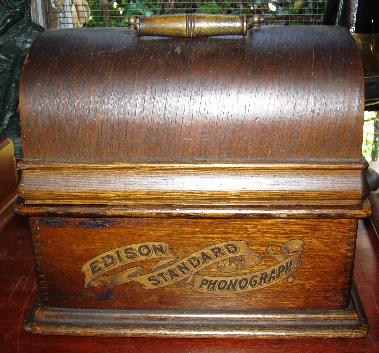



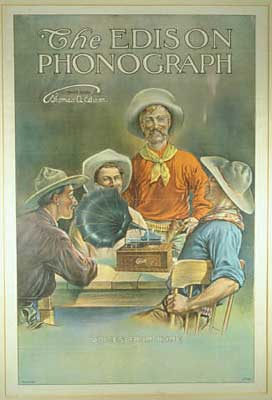
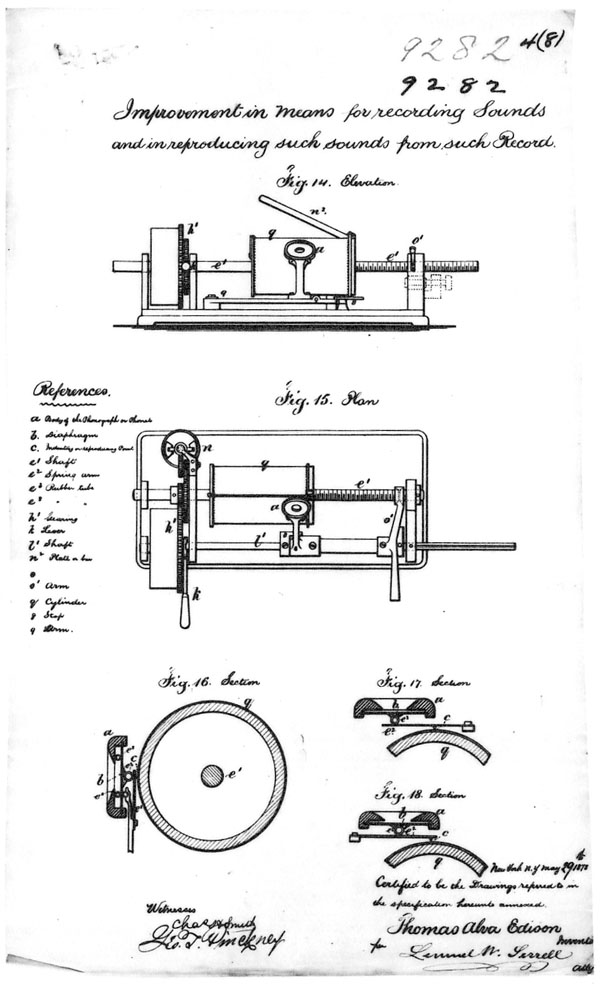
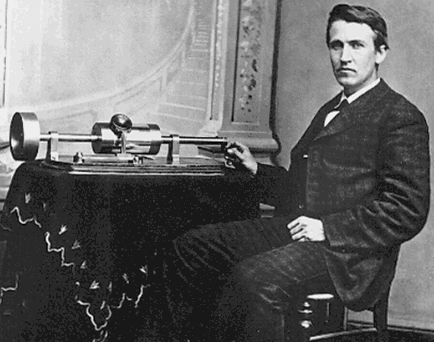

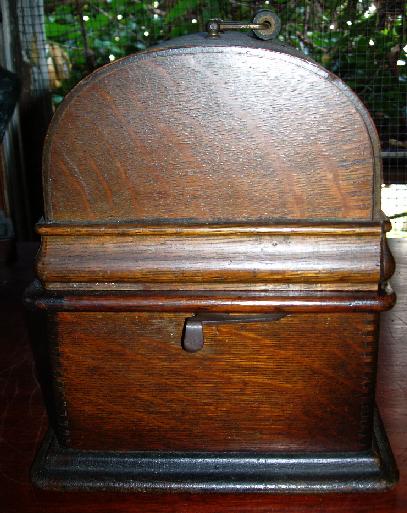
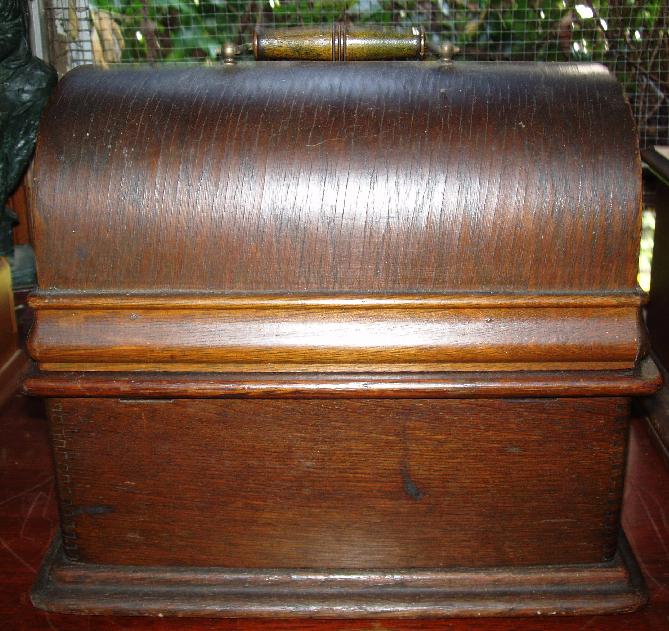

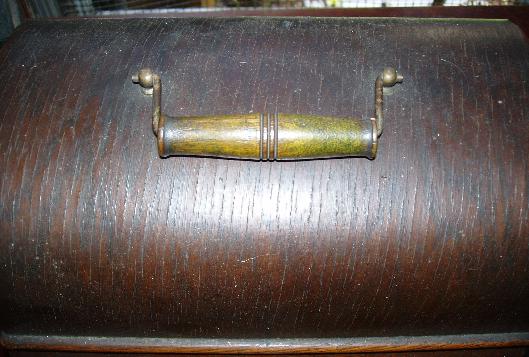
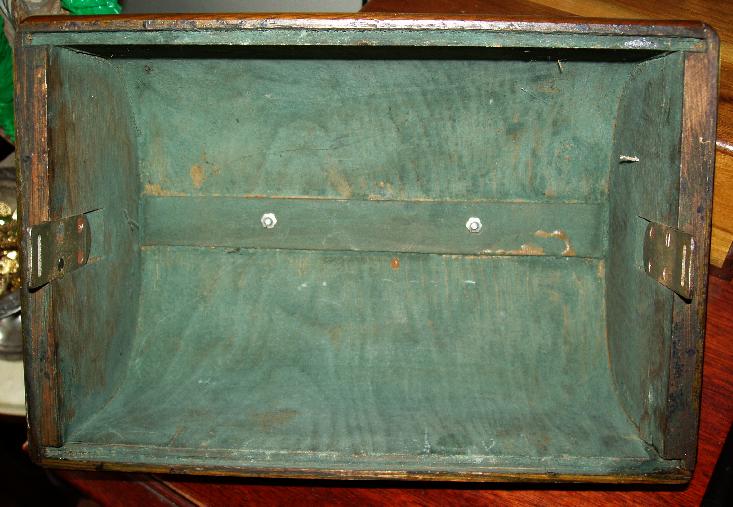





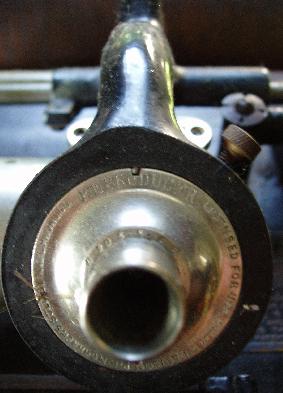






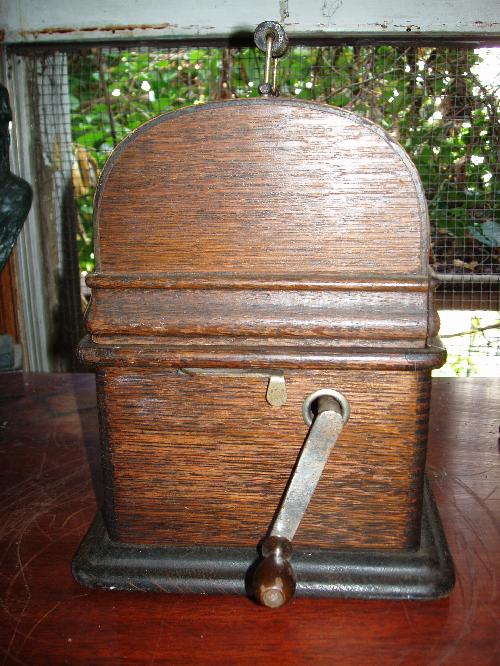
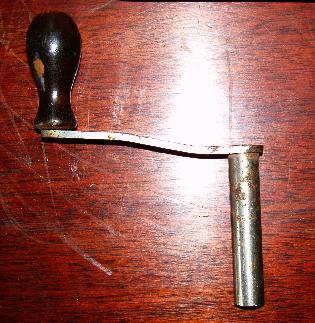


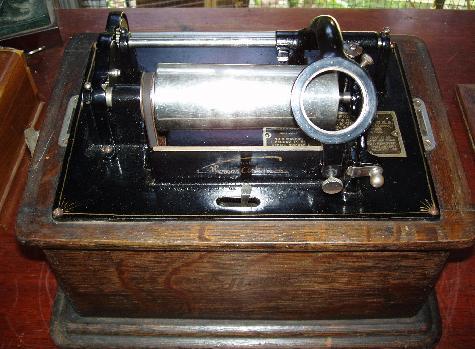
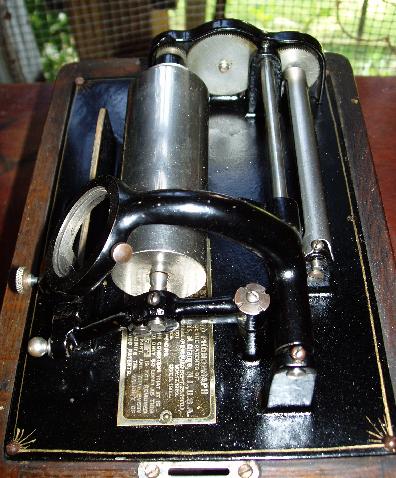

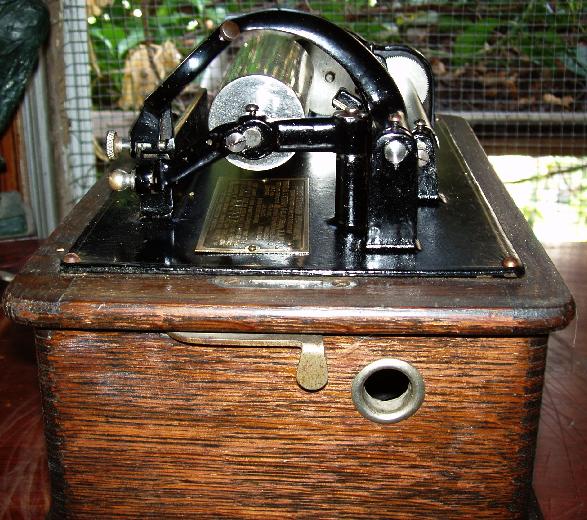
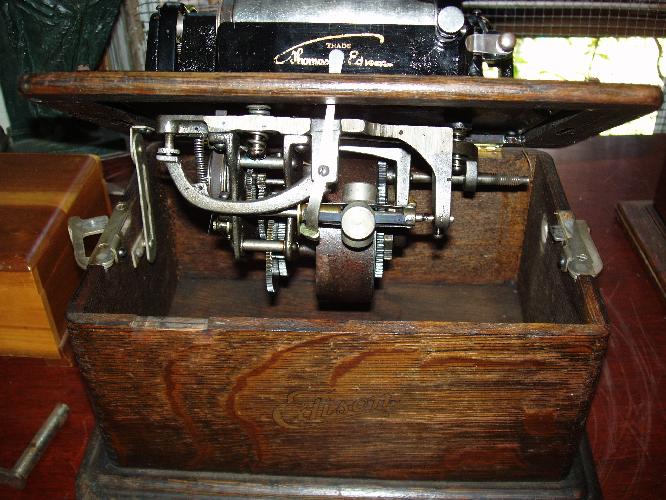

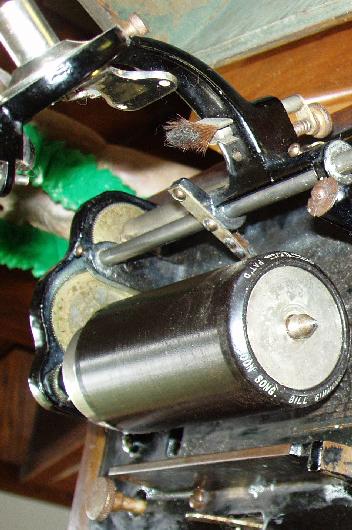 Cylinder
on mandrel
Cylinder
on mandrel Playing!
Playing!